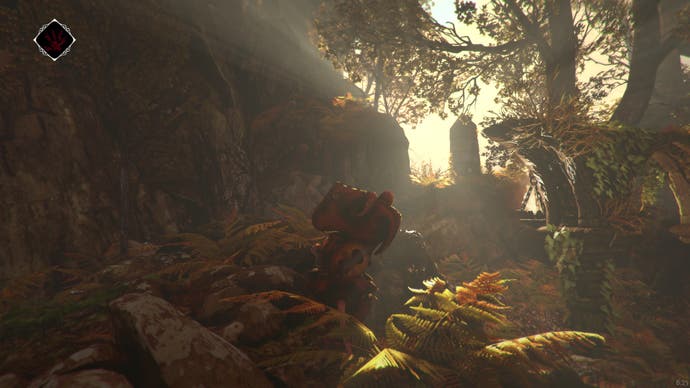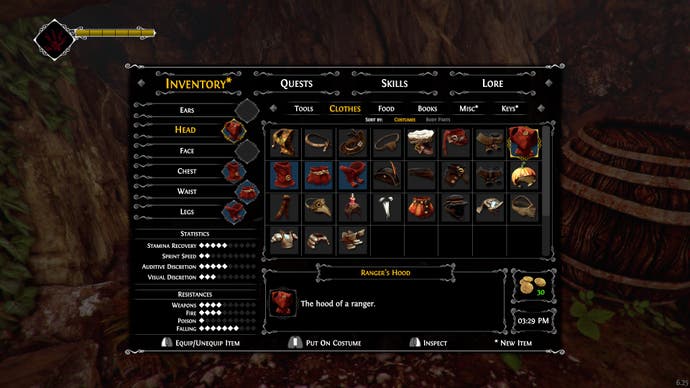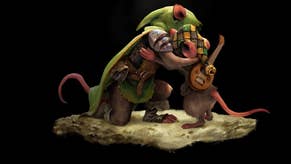Ghost of a Tale review - a creature castle fantasy with plenty of Soul
Escape the ratrace.
Ghost of a Tale's castle feels like a prison at first but ends up feeling like home. In the course of 20 hours searching for a way out, I've slowly fallen in love with the place - its feathery falls of afternoon light over mossy stonework, its leafblown ramparts and canted mausoleums, its small, hard-bitten population of anthropomorphic rats, mice, frogs and magpies. Part of the setting's allure is that it carries the echoes of many great virtual fortresses. Indeed, this slightly muddled third-person action-RPG's greatest strength is probably how it adds to that architectural tradition, though the witty, affecting, politically resonant writing runs a close second.
There's a touch of Square Enix's winding masterpiece Vagrant Story to certain overgrown, shady courtyards, and a generous dollop of both Zelda and Moria in the shape of a magnificent underground vault, woven around a circular puzzle structure. The view from the keep's belfry recalls the view inland from ICO's fortress walls, yellow crenelations biting into blissful green distances. Above all, there's the spectre of Dark Souls - a game with which Ghost of a Tale engages in fascinating, not always successful ways. As with From Software's Lordran, Dwindling Heights Keep is a purgatory for lost people and things that is much taller than it is broad, stretching from a bone-strewn shoreline up through catacombs and sewers to a barracks, kitchen and armoury. Like Lordran, it's a persistent environment bound together by a profusion of cunning shortcuts, unlocked one by one - rope elevators that whisk you from the gardens to the signal tower, doors that open from one side only and secret passages cheekily visible through rusted grates.

Working out how the game's spaces thread into one another, letting their twists and turns sink into muscle memory, is as integral to Ghost of a Tale's appeal as its hypnotic good looks. The act of stitching those wayward, ruined chambers together also chimes with the narrative, a story about rediscovering the past and building trust across racial divides that is a lot more searching than its parade of waggling tails and frog beards might suggest. Ghost of a Tale is the tale of Tilo, a mouse minstrel thrown in the clinker after his wife Merra angers a rat baron by refusing to perform a certain song. He is soon sprung from his cell by a mysterious figure, and left to scour the rambling keep for an exit while trying to learn the fate of his spouse. You'll meet plenty of potential allies in the process, from argy-bargy thieves through grandmotherly cooks to gloating apothecaries, all of whom will send you off on various errands before they'll agree to help you.
The game's missions mostly consist of fetchquests, but there's the odd simple platforming sequence or physical puzzle such as activating artefacts in order, plus a few "dialogue battles" where you must pick the right responses to stop a character losing patience. It's a very forgiving to-do list, probably too forgiving for its own good - working out the right route aside, you'll only really ever have to worry about finding candles or lamp oil to light your path, with no weapons or tools to wield save throwable distraction items and the odd (inexplicably) explosive pinecone. The delight of delving deeper into the fortress lends even the most humdrum oddjob a certain thrill, however, and there's the odd setup that exploits the sumptuous environment design to great effect. Among my favourites is a restful mushroom-picking quest which saw me using a mycology handbook to identify the right growing conditions for certain fungus breeds, peering at leaf shapes and fallen logs while avoiding the gaze of a patrolling guard.

Ghost of a Tale's willingness to let the world articulate itself to the player rather than leaning on HUD aids recalls both Dark Souls and Morrowind, patron saint of fashionably weird fantasy RPGs, but let's not get too carried away there - SeithCG's game is no Elder Scrollsy character development marathon. Quests generate XP, but level-ups only boost your health and stamina, and while there are a few minor abilities and perks such as reduced fall damage to acquire from certain characters, they're strictly optional - you'll carry out the missions concerned more for the sake of getting to know people than transforming yourself into the fourth Mouseketeer.
Tilo himself is a lovely, winsome creation, particularly when he's wobbling about in the caverns with a candlestick in his paw. As far as many of the game's other characters are concerned, however, he's the scum of the earth. In Ghost of a Tale's quasi-medieval world mice are a despised underclass, forever tainted by the treachery of their ancestors during an ancient war with an entity known as the Green Flame. Rats, conversely, are the heroes who finally drove back the demonic adversary, a legacy that has allowed them to gain power over the other species and establish a brutal regime.
The enmity between species soon becomes crucial to the plot - specifically, who you decide to trust at key intervals - and colours more or less every interaction or piece of textual backstory, from the mouthy bigoted frog you'll encounter in the cell next to yours to the rowdy ballads in Tilo's songbook, one of which is a sugary incitement to genocide. The obvious realworld parallel for the ostracisation of mice is the Christian stereotype of the Jews as a people cursed by the death of Jesus, but if this is to some degree an allegory, it's at once very open-ended and never remotely preachy.

Rather than being parachuted into the universe, the question of prejudice is simply part of its terrain, the bitter soil from which people grow much as sexism is baked into the social bedrock of The Witcher games. The script is very much a master of that terrain, managing the intricacies with grace and sensitivity. It never boils characters down to their intolerances - almost everybody has a sympathetic side, however crude and vicious they might seem - and handles tricky phenomena like the concept of micro-aggressions with enviable deftness. It's also both very funny at times and extremely poignant at others - capable of a lot of tonal subtlety despite the absence of voice-acting, and happy to leave certain implications unsaid.
The question of race somewhat guides Ghost of a Tale's blend of stealth and disguises, but sadly the game is much less compelling on this front. Tilo is almost completely defenceless, though you can equip different gear pieces to boost your resistance to direct damage, poison and fire. Accordingly, you'll spend a lot of the game lurking in barrels (which double as save points) waiting for guards to pass, or crouching to lower footstep noise. The game's enemy AI is bare-bones to the point of crumbling away in your hands: rat guards either stand in place or trundle back and forth like catwalk models, forgetting you were there a few seconds after reaching your last known position. Outside of dialogue, there's little sense that you are a convict on the run from hotly pursuing authorities, and little satisfaction to glean from outwitting anybody. You can lob sticks and bottles to distract guards, but it's often easier just to gallop straight through to a hiding spot on the other side of the area.
Fortunately, Tilo soon gains access to the aforesaid disguises, beginning with a beat-up suit of rat armour that hinders movement but lets you pass as one of the prison guards. Many of the crucial quests involve dressing up as celebrity rogues, pirates, nobles and so forth to bamboozle people and learn their secrets. It's all very silly - think pumpkin masks and eyepatches that somehow improve your vision - but it's also part of the story's more serious preoccupation with ethnicity and discrimination, as suggested by a lore entry on the politics of religious attire. You can dress up as a kind of mouse secret policeman to stop guards attacking you, but they'll resent and harass you all the same, stealing food or threatening to lock you up unless you pay a bribe. The game could have done much more with the disguise concept - beyond making back-tracking less troublesome, it never really transforms how you play outside of dialogue - but it's provocative and intriguing where the stealth too often feels like an inconvenience.

There are times when Ghost of a Tale seems ill at ease in its own clothes, its bewitching play of vegetation and masonry not quite disguising the project's relatively limited means. The array of quests is possibly too large for the map - you'll often pick up objects before you know what they're for, starting a quest only to discover that you've already put together the means to complete it. The current version of the game is, moreover, absolutely riddled with bugs, from trifles like map icons not appearing to more grating problems such as missions refusing to complete till you quit the game and reload.
The worst technical upsets helpfully coincide with the worst of the story and encounter design. Having done without such theatrics for most of its length, Ghost of a Tale ends with an agonising boss encounter which requires you to drag heavy objects around while allies try to fend off those enemies not already trapped by a swarm of pathfinding and animation glitches. In the process, what was once a story about a few, troubled souls in an out-of-the-way corner suddenly becomes a story about the fate of a kingdom, trading intimacy for grandeur with a dispiriting clang.
It's a soggy, rushed-feeling finale, but none of that's enough to kill off my enthusiasm for Dwindling Heights and its denizens - as I write these words, I'm itching to shrug on my preposterously oversized rat armour and take another tour of that central courtyard. There is so much to say about Ghost of a Tale, from the way its stooped and ivy-clad architecture engages with a proud history of video game citadels, through its status as a sort of combat-less Elder Souls knock-off, to the way its writing surfs the line between personality and critique. It is not always great fun to play, but it is always worth pondering, and its mournful, majestic setting will linger in your mind long after the taste of that final encounter has faded.











